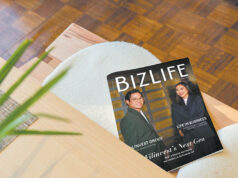AI-generated poetry, paintings, and drawings: Is it still art?
By Zsarlene B. Chua, Joseph L. Garcia, and Michelle Anne P. Soliman
Reporters
FAIR-SKINNED, brown-eyed, and dark-haired, Ai-Da speaks with an English accent. She wears a white long-sleeved blouse and black trousers. Since April, she has been studying her subjects and sketching them using her bionic arm in a company in Cornwall, England.
Estela Vadal stands against the wall of a bookshop in Maginhawa St., Quezon City. Her bright eyes recognize the face of the person who stands in front of her and she takes a photo. After a few seconds, she asks the person to wait. Like a Polaroid photo, a printed receipt is then produced with the person’s photo and a short Filipino poem below. “Naghihintay lamang ako sa pag-ibig, upang ibalik ang lahat ng iyong nalimutan,” read the first stanza.
Ai-Da and Estela are both robots.
Art is driven by emotion, and since man started to think and feel, they have long considered art to be the sole purview of man. While animals can think, and feel emotions, humans have far more ability to execute and express desires and fears resulting in work that cements who they are in time.
However, recent developments in human-driven technology have created art done through artificial intelligence.
Machines capable of artificial intelligence, those that retain and improve upon information they received, have shown that they can perform tasks above the mundane: practicing law and journalism, for example, at near-human speed and efficiency.
While automation has long been feared by several labor sectors because of the mathematical efficiency of robots that do jobs usually performed by humans, those in the creative fields have sat back, assured that their contributions to society can never be replaced by a computer.
Until now.
Edmond de Belamy, a portrait, was auctioned off in October 2018 at Christie’s for $432,000, a leap from its estimate of $7,000 to $10,000. Edmond de Belamy was created by Obvious, an art collective based in Paris, using Generative Adversarial Networks (GAN). “It’s an artificial intelligence algorithm used to synthesize images,” said the members of Obvious in an e-mail to BusinessWorld.
Obvious is composed of “three childhood friends [who] wanted to do something creative together”: Hugo Caselles-Dupré, Pierre Fautrel, and Gauthier Vernier. “We [were] all fascinated by technology and Hugo had the chance to study artificial intelligence in college. He came across GANs and that sparkled the idea of using AI to do art. The collective is called Obvious because we want to democratize AI and explain it so that it becomes obvious what AI is at the moment,” they wrote in an e-mail.
In an article on Christie’s official website, Obvious member Mr. Caselles-Dupré outlined the process of creating Edmond: “The algorithm is composed of two parts. On one side is the Generator, on the other the Discriminator. We fed the system with a data set of 15,000 portraits painted between the 14th century and the 20th. The Generator makes a new image based on the set, then the Discriminator tries to spot the difference between a human-made image and one created by the Generator. The aim is to fool the Discriminator into thinking that the new images are real-life portraits. Then we have a result.”
GAN was invented by scientist Ian Goodfellow in 2014. “GANs have been used for creative purposes since their creation in 2014,” said the members of Obvious. For example, they have been used to synthesize the faces of models and humans for advertisements, and improving upon images used in astronomical research.
Ai-Da, who was named after a British mathematician and computer pioneer Ada Lovelace, is considered to be the “first humanoid robot artist.” Created by British inventor and gallery owner Aidan Meller, she is built with cameras in her eyes and AI algorithms which help coordinate her arm to create art.
Rather than replicate the art she sees, she interprets it and produces a different output despite studying the same subject.
“We do not quite know how the output is going to be when she does a drawing. We just felt that she needed to have a[n] expressive style,” Mr. Meller told CBC radio.
Inspired by technologist Ross Goodwin’s AI machine which prints English poetry, Filipino programmer and poet Marlon Hacla created Estela Vadal (whom he named after his mother), the “first robot that prints poetry in Filipino.”
The engine that Mr. Goodwin used, explained Mr. Hacla, was based on the character-level language model called char-RNN by Andrej Karpahty, director of the artificial intelligence department and autopilot vision of American automotive and energy company Tesla. “[The engine is where] you can basically prepare a text that the software can study and after the software has learned the text, it can learn the text on its own,” Mr. Hacla told BusinessWorld in an interview on June 8 in Katipunan, Quezon City.
Mr. Hacla used Ross Goodwin’s engine as a basis in the creation of Estela.
“Ang gusto ko lang was to see a robot na kayang tumula (I only wanted to see a robot capable of writing poems). Ganoon lang ka-simple yung motive (That’s how simple my motive was),” Mr. Hacla said about his motivation to create Estela. The robot evolved from a Twitter-bot that generated poetry that he made in 2017. “We’re in the age now [where] we have the technology to teach a machine to create poetry,” he said.
“I was interested [in getting] people to read the poetry,” he said. To encourage people to try the robot, Mr. Hacla added the camera feature.
The robot was completed in 2018 and was first exhibited at Roel’s Bookshop in Quezon City.
IS IT ART?
Andrew Conru, founder of the annual robotic competition Robot Art Competition Exhibition, said that artistic creations are diverse. “Every generation tries to come up with a new genre, a new style, a new category of art. I don’t see robot art as any different than yet another way for people to express themselves,” Mr. Conru said in an interview with Creators, a sub-domain of Canadian digital media company Vice Media.
Mr. Conru is an internet entrepreneur behind the first online dating site WebPersonals and Adult FriendFinder.
“The camera didn’t invalidate the portrait artist, as the portrait artist was often trying to capture a deeper emotion [rather than] a perfect copy of the sitter,” Mr. Conru writes on the competition’s webpage. “However, the camera opened up a whole new form of art — photography. Likewise, human-generated art will always be highly respected not only for its creativity, but… our shared human experience.”
“It’s a new type of art, which is really exciting. Think of it as the new camera: it gives the artist so much more ways to express himself,” the members of Obvious said of the new medium of artificial intelligence.
The new technology as incorporated in art has been a recent success. However, limitations remain and improvements are yet to be done.
“It’s very hard to make them work, it’s unstable, we don’t fully understand why it works… There a ton of room for improvement here and that’s what researchers are tackling,” wrote the members of Obvious.
According to Dave King, founder of creative AI company Move 37, creativity is not a God-given thing. It’s a process, and it takes practice. “Art is one of the last domains in AI where there is an optimistic view on how humans and machines can work together,” said Mr. King.
But then one comes up against the question: Should AI-generated artworks be considered art since these were not created by humans?
For art collective Obvious, it is considered art. “It is still art since the intention comes from a human.”
Richie Lerma, Salcedo Auctions director and former curator of the Ateneo Art Gallery, agrees. “The technologies behind AI are still created by human minds, and so it would stand to reason that they can still be considered to be human creations,” he told BusinessWorld in an e-mail.
On the other hand, Mr. Hacla said it remains a complicated situation. “I designed how she (Estela) learned and generates text. I would like to take credit since I designed the text she studied and how she generates it. I could claim na ’yung poems na gine-generate niya (that the poems she generates) are actually my poems. But that is not the case,” he said, adding that intellectual property in this case remains a debatable subject.
“That’s what is interesting. Who now owns Estela Vadal poems?,” he asked. “Akin ba siya? Kasi parang hindi. Akin yung robot. Pero hindi ko alam kung pwede ko bang i-claim na akin rin yung poems niya (Are they mine? I don’t think so. The robot is mine. But I do not know if I can claim ownership of its poems),” he said.
THE HUMAN RESPONSE
In the international scene, artist collective Obvious and Aidan Meller are not alone is exploring the world of AI-generated art.
The third Robot Art Competition and Exhibition received 100 submissions last year. The 2018 winner was Pindar Van Arman with three paintings: two AI-generated portraits “made with varying degrees of abstraction” (according to Van Arman’s website, www.cloudpainter.com) and a rendition of Paul Cezanne’sHouses at the L’Estaque.
Mr. Van Arman said in his blog, “For each of the past three years, internet entrepreneur Andrew Conru has sponsored a $100,000 international competition to build artistic robots called RobotArt.org. His challenge was to create beautiful paintings with machines and the only steadfast rule was that the robot had to use a brush… no inkjet printers allowed.”
Even before the opening of Ai-Da’s first solo exhibition at St. John’s College in Oxford, England on June 12, her works on view — 20 paintings (actually canvases which are printed with her work then painted over by a human), two videos, and four sculptures — had already been sold for over $1.2 million.
According to her creator, Mr. Meller, the emergence of AI is an opportunity to experiment on its positive and negative effects.
“We’re doing it because we’re actually very, very concerned about the use and abuse of AI, Mr. Meller told CBC radio.
He added that there are future plans to make Ai-Da to paint and create pottery.
Meanwhile, Obvious noted that the scenario of AI superceding humans is yet unforeseen.
“It’s impossible to forecast such a thing. The best we can say is that for now AI Art is much more human than people tend to believe,” the members of Obvious wrote.
“What we can notice is that humans are very afraid of machines ever replacing them one day. Maybe this fear is what will prevent such a thing from happening,” they added.
As for the local art scene, more creations of AI-generated art are yet to be seen by the public.
“I would like these artworks to first be shown at galleries, whose task it is to develop and expand audiences,” Mr. Lerma wrote in an e-mail. “As an auction house, we deal primarily with the secondary market, and would thus gauge marketability on the local market’s response to AI-generated art.”
Estela Vadal has been exhibited in various art and literature festivals such as the 2019 Performatura at the Cultural Center of the Philippines, the Philippine International Literature Festival (PILF) hosted by the National Book Development Board (NBDB), and the Manila Mini Maker Faire at the Mind Museum. According to Mr. Hacla, negotiations are ongoing with the Quezon City Department of Education (DepEd) for the robot poet to tour public schools in the future.
“[The presence of artificial intelligence] is now happening in the international scene. However, the way people are responding to it, they are not prepared. They do not know how they will respond to these kinds of artworks since it is something new. We are still trying to figure out how people are going to respond to it,” Mr. Hacla said.
As an example, Mr. Hacla said that he once invited students to try the robot while it was on exhibit at the bookshop. “I observed that the kids were only interested in getting their photo taken. But somehow, the kids went home with poetry even if they usually do not read poems. I did not realize na napabasa ko ng tula yung mga bata (I got the kids to read poetry),” he said.
“There are dynamics that you will only know when you show the artwork to the people. We can only try to present it to them and see how they will respond,” Mr. Hacla said.
As for how AI will affect the future of local art scene, Mr. Lerma remarked, “That remains to be seen.”



